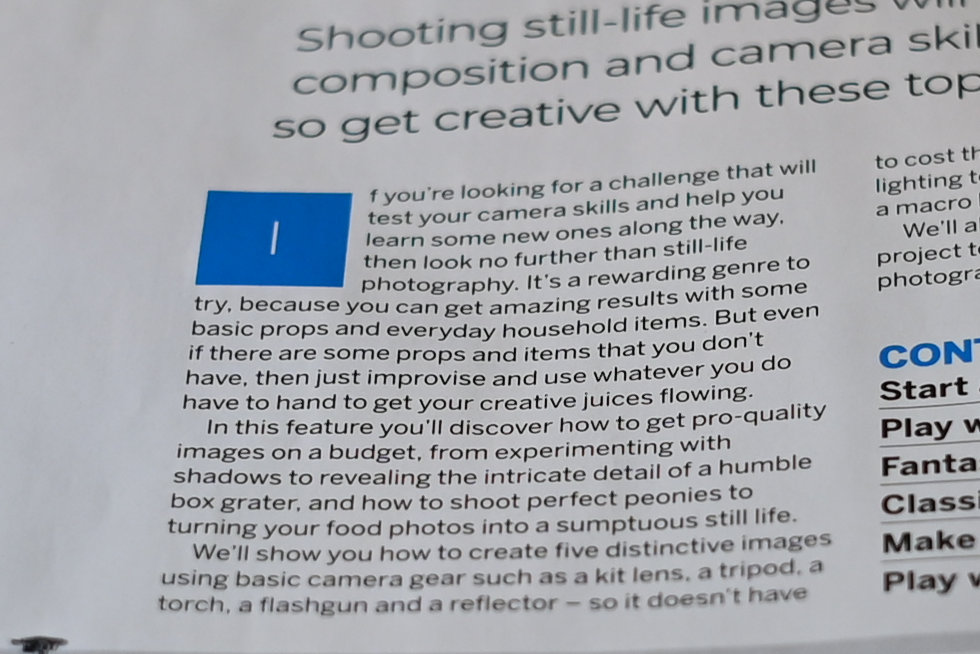Digital Camera World Verdict
Super-fast lenses aren’t always big, heavy and expensive. This full-frame compatible Laowa wide-angle lens for mirrorless cameras cuts everything down to size with a modest size, weight and selling price, despite having an f/1.2 aperture rating and robust metal construction. It’s a fully manual lens, so you need to set the focus distance and aperture via onboard control rings, but it works and handles well, delivering very pleasing image quality.
Pros
- +
High-quality construction
- +
Impressive image quality and handling
- +
Click/de-click aperture ring switch
Cons
- -
Manual focus and aperture control
- -
Mediocre wide-aperture edge-sharpness
- -
Not weather-sealed
Why you can trust Digital Camera World
The Laowa Argus 28mm F1.2 FF from Venus Optics follows in the confident footsteps of several predecessors in the Argus range, designed for both full-frame and crop-sensor mirrorless cameras. Previous lenses in the series have all shared an ultra-fast 0.95 aperture rating, but the 28mm is about an f/stop slower at f/1.2. That’s still super-fast in our books and an upside is that the lens is surprisingly compact and lightweight for such a speedy, full-frame compatible prime. Engineered for mirrorless cameras, it’s available in Canon RF, Leica L, Nikon Z (FX) and Sony E (FE) mount options, the L-mount version also hitting the marque for Panasonic and Sigma bodies.
Specifications
Mount: Canon RF, Leica L, Nikon Z (FX), Sony E (FE)
Full frame: Yes
Image stabilization: No
Autofocus: No
Lens construction: 13 elements in 7 groups
Angle of view: 75.4 degrees
Diaphragm blades: 13
Minimum aperture: f/16
Minimum focusing distance: 0.5m
Maximum magnification ratio: 0.07x
Filter size: 62mm
Dimensions: 69x106mm
Weight: 562g
Key features
That fast f/1.2 aperture is the standout key feature but, as with other dubiously titled ‘dumb lenses’ the Laowa lacks a CPU (Central Processor Unit) so there’s no electronic communication with the camera body. As such, it’s a fully manual lens and neither autofocus nor camera-controlled aperture adjustment is available and no EXIF data is stored in image files. That’s not a deal-breaker, as we’ll come to later in ‘build and handling’. In the Nikon Z-mount version that we tested, it proved easy to input the lens’s vital statistics in cameras that feature IBIS (In Body Image Stabilization), beating the shakes in handheld shooting.
Up-market glass includes one aspherical element and two HR (High Refractive index) elements, aiming to boost sharpness while reducing the overall size and weight, along with two ED (Extra-low Dispersion) elements to enhance clarity and minimize lateral chromatic aberration, or color fringing.
The aperture diaphragm is particularly well-rounded, based on 13 curved blades. This helps to improve the quality of bokeh when stopping down a little, giving a more circular shape to bokeh discs derived from defocused lights and other bright spots in a scene.
To reduce ghosting and flare, the lens is supplied complete with a bayonet-fit hood that has a rectangular profile. It works very effectively but is a bit impractical for use with the likes of screw-in circular polarizing filters that require rotational adjustment.
Build and handling
Although very lightweight for a full-frame compatible f/1.2 lens, the Laowa feels very sturdy and robust, with a full-metal build that stretches to the mounting plate, barrel and even the hood. The only constructional downside is that the lens isn’t weather-sealed. That’s no real surprise, given the budget-friendly selling price for an f/1.2 prime.
An essential of any manual-focus lens is that the focus ring operates smoothly and enables fine precise adjustments. That’s certainly the case with this Laowa. Further bonuses include a focus distance scale that’s calibrated in feet and meters, along with depth of field markers for apertures of f/1.2, f/4, f/5.6, and f/11. Both the focus distance scale and DOF markers serve as a guide but you’ll still need to keep an eye on sharpness in the viewfinder or rear screen when composing shots.
Accurate manual focusing is typically much easier with mirrorless cameras compared with DSLRs, as the exposure preview option gives a viewfinder image that remains bright at narrower apertures, and ‘focus peaking’ is generally available to highlight the edges of objects as they come into focus. A magnified preview can also be a big benefit for pinpoint manual focusing.
As a fully manual lens, you’ll also need to adjust the aperture using the onboard control ring rather than from the host camera body. Again, that’s generally no major hardship but it does mean you can’t shoot effectively in Program AE or Shutter-priority modes. On the plus side, the lens has the handling benefit of a click/de-click switch, making the aperture ring more suitable for stills and video shooting respectively. It’s not all top news though, as click steps are only implemented for full f/stops, rather than the more usual one-third f/stop increments.
The best camera deals, reviews, product advice, and unmissable photography news, direct to your inbox!
Performance
Manual focusing works pretty painlessly, even for the uninitiated, and the fairly generous depth of field at medium to narrow apertures makes life easier in general shooting. On the other hand, generously wide apertures deliver a tight depth of field for close-ups, where the lens gives a pleasantly smooth bokeh. Focus breathing is very minimal so the focus distance stays fixed as you sweep through the aperture range, which is a bonus for videography.
Outright sharpness is impressive overall. In the central region of the image frame, sharpness remains good even when shooting wide-open at f/1.2, although you need to stop down to f/2.8 before edge/corner sharpness gets into its stride. From f/2.8 right through to f/16, center-sharpness is excellent.
While sharpness improves at medium to narrow aperture settings, color fringing becomes slightly more noticeable towards the edges and corners of the frame. Even so, it’s still quite well controlled and the lens performs well in terms of axial chromatic aberration or ‘bokeh fringing’, which is always a challenge for fast lenses at their widest aperture settings. This displays as color fringing around high-contrast edges in a scene that falls just in front of or behind the plane of focus, across the whole image frame. But there’s negligible axial aberration to be seen even at the widest aperture of f/1.2, where vignetting is pretty well restrained, especially considering the lens’s bright aperture and downsized construction.
Unlike many recent lenses designed for mirrorless cameras, there’s no reliance on automatic in-camera correction for distortion. The lens gives only minimal barrel distortion rarely requiring a software fix at the editing stage. And when needed in the likes of architectural photography, an editing fix is easy to apply thanks to the uniform nature of the slight barrel distortion. Resistance to ghosting and flare is also very good.
All in all, performance is very pleasing, making the Laowa a desirable super-fast prime lens with a refreshingly modest size, weight, and price tag, and a smart buy.
Sample images

f/1.2
This series of tightly cropped images taken at the minimum focus distance of 0.5m shows how center-sharpness is retained well at wide apertures of f/1.2, f/1.4, f/2 and f/2.8, and that axial chromatic aberration or ‘bokeh fringing’ is negligible even when shooting wide-open.

f/1.4
This series of tightly cropped images taken at the minimum focus distance of 0.5m shows how center-sharpness is retained well at wide apertures of f/1.2, f/1.4, f/2 and f/2.8, and that axial chromatic aberration or ‘bokeh fringing’ is negligible even when shooting wide-open.

f/2
This series of tightly cropped images taken at the minimum focus distance of 0.5m shows how center-sharpness is retained well at wide apertures of f/1.2, f/1.4, f/2 and f/2.8, and that axial chromatic aberration or ‘bokeh fringing’ is negligible even when shooting wide-open.

f/2.8
This series of tightly cropped images taken at the minimum focus distance of 0.5m shows how center-sharpness is retained well at wide apertures of f/1.2, f/1.4, f/2 and f/2.8, and that axial chromatic aberration or ‘bokeh fringing’ is negligible even when shooting wide-open.

f/1.2
This series of shots demonstrates the quality of bokeh when shooting wide-open, and stopping down to f/2 and f/2.8

f/2
This series of shots demonstrates the quality of bokeh when shooting wide-open, and stopping down to f/2 and f/2.8

f/2.8
This series of shots demonstrates the quality of bokeh when shooting wide-open, and stopping down to f/2 and f/2.8
Lab results
We run a range of lab tests under controlled conditions, using the Imatest Master testing suite. Photos of test charts are taken across the range of apertures and zooms (where available), then analyzed for sharpness, distortion and chromatic aberrations.
We use Imatest SFR (spatial frequency response) charts and analysis software to plot lens resolution at the center of the image frame, corners and mid-point distances, across the range of aperture settings and, with zoom lenses, at four different focal lengths. The tests also measure distortion and color fringing (chromatic aberration).
Sharpness:
Center-sharpness is good at f/1.2 to f/1.4 and excellent from f/2 all the way through to the narrowest aperture of f/16. Mid-to-edge sharpness is less impressive at f/1.2 to f/1.4 but comes on song at f/2.8 and narrower apertures.
Fringing:
Axial chromatic aberration is minimal even at the widest aperture of f/1.2, where lateral chromatic aberration is also fairly slight. The latter ramps up a bit as you narrow the aperture and can be a little noticeable towards the edges of the frame when uncorrected.
Distortion: -0.89
There’s a touch of barrel distortion but, compared with many recent lenses designed for mirrorless cameras that rely very heavily on in-camera correction, it’s very slight. In most cases, distortion will be unnoticeable but it’s uniform in nature and easy to correct at the editing stage, for example in architectural photography.
Verdict
Super-fast lenses aren’t always big, heavy and expensive. This full-frame compatible Laowa wide-angle lens for mirrorless cameras cuts everything down to size with a modest size, weight and selling price, despite having an f/1.2 aperture rating and robust metal construction. It’s a fully manual lens, so you need to set the focus distance and aperture via onboard control rings, but it works and handles well, delivering very pleasing image quality.
Read more:
• Best camera lenses
• Best Canon lenses
• Best Nikon lenses
• Best Sony lenses
Matthew Richards is a photographer and journalist who has spent years using and reviewing all manner of photo gear. He is Digital Camera World's principal lens reviewer – and has tested more primes and zooms than most people have had hot dinners!
His expertise with equipment doesn’t end there, though. He is also an encyclopedia when it comes to all manner of cameras, camera holsters and bags, flashguns, tripods and heads, printers, papers and inks, and just about anything imaging-related.
In an earlier life he was a broadcast engineer at the BBC, as well as a former editor of PC Guide.












